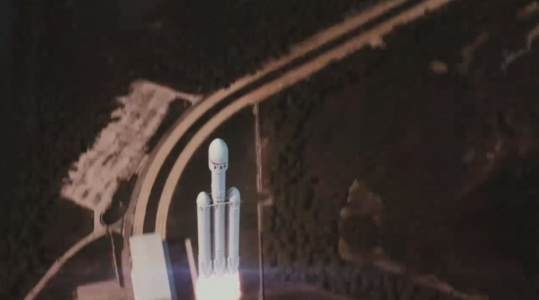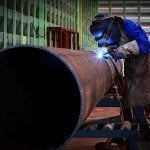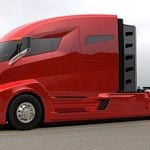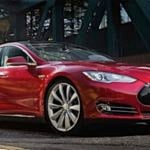Elon Musk was hedging his “bets” when he said today’s hugely anticipated test launch of the Falcon Heavy will be a “great rocket launch or the best fireworks display.” Watch the launch of “the biggest rocket in the world by far” (Elon Musk): live at 3:04 PM ET to see which kind of spectacular display.
Live feed from SpaceX, or PBS News hour (both below) (Mission details below videos):
Space X live coverage:
PBS Newshour Coverage:
The first test flight of Falcon Heavy is now targeted for Tuesday, Feb. 6th at 3:05 PM ET from Launch Complex 39A at Kennedy Space Center in Florida. Teams are watching upper level wind shear and will continue to update as information becomes available.
When Falcon Heavy lifts off, it will be the most powerful operational rocket in the world by a factor of two. With the ability to lift into orbit nearly 64 metric tons (141,000 lb)—a mass greater than a 737 jetliner loaded with passengers, crew, luggage and fuel–Falcon Heavy can lift more than twice the payload of the next closest operational vehicle, the Delta IV Heavy, at one-third the cost.
Falcon Heavy draws upon the proven heritage and reliability of Falcon 9. Its first stage is composed of three Falcon 9 nine-engine cores whose 27 Merlin engines together generate more than 5 million pounds of thrust at liftoff, equal to approximately eighteen 747 aircraft. Only the Saturn V moon rocket, last flown in 1973, delivered more payload to orbit. Falcon Heavy was designed from the outset to carry humans into space and restores the possibility of flying missions with crew to the Moon or Mars.

Mission Overview
SpaceX is targeting launch of the Falcon Heavy demonstration mission on Tuesday, February 6 from Launch Complex 39A (LC-39A) at NASA’s Kennedy Space Center, Florida. The primary launch window opens at 3:05 p.m. EST, and closes at 4:00 p.m. EST, or 21:00 UTC. A backup launch window opens on Wednesday, February 7 at 1:30 p.m. EST, or 18:30 UTC, and closes at 4:00 p.m. EST, or 21:00 UTC.
When Falcon Heavy lifts off, it will be the most powerful operational rocket in the world by a factor of two, with the ability to lift more than twice the payload of the next vehicle, at one-third the cost. Only the Saturn V moon rocket, last flown in 1973, delivered more payload to orbit.
Three cores make up the first stage of Falcon Heavy. The side cores, or boosters, are connected to the center core at its base and at the vehicle’s interstage. With a total of 27 Merlin engines, Falcon Heavy’s three cores are capable of generating more than 5 million pounds of thrust.
For this test flight, Falcon Heavy’s two side cores are both flight-proven. One launched the Thaicom 8 satellite in May 2016 and the other supported the CRS-9 mission in July 2016. SpaceX will attempt to land all three of Falcon Heavy’s first stage cores during this test. Following booster separation, Falcon Heavy’s two side cores will attempt to land at SpaceX’s Landing Zones 1 and 2 (LZ-1 and LZ-2) at Cape Canaveral Air Force Station, Florida. Falcon Heavy’s center core will attempt to land on the “Of Course I Still Love You” droneship, which will be stationed in the Atlantic Ocean.
The payload for Falcon Heavy’s demonstration mission is SpaceX CEO and Lead Designer Elon Musk’s midnight-cherry Tesla Roadster. Demonstration missions like this one typically carry steel or concrete blocks as mass simulators, but SpaceX decided it would be more worthwhile to launch something fun and without irreplaceable sentimental value: a red Roadster for the red planet. Following launch, Falcon Heavy’s second stage will attempt to place the Roadster into a precessing Earth-Mars elliptical orbit around the sun.
It’s important to remember that this mission is a test flight. Even if we do not complete all of the experimental milestones that are being attempted during this test, we will still be gathering critical data throughout the mission. Ultimately, a successful demonstration mission will be measured by the quality of information we can gather to improve the launch vehicle for our existing and future customers.
Mission Timeline (all times approximate)
COUNTDOWN
Hour/Min/Sec Events
– 01:28:00 SpaceX Launch Director verifies go for propellant load
– 01:25:00 RP-1 (rocket grade kerosene) loading underway
– 00:45:00 LOX (liquid oxygen) loading underway
– 00:07:00 Falcon Heavy begins engine chill prior to launch
– 00:01:00 Flight computer commanded to begin final prelaunch checks
– 00:01:00 Propellant tank pressurization to flight pressure begins
– 00:00:45 SpaceX Launch Director verifies go for launch
– 00:00:05 Engine controller commands side booster engine ignition sequence to start
– 00:00:03 Engine controller commands center core engine ignition sequence to start
– 00:00:00 Falcon Heavy liftoff
LAUNCH, LANDINGS AND ORBITAL INSERTION
Hour/Min/Sec Events
00:01:06 Max Q (moment of peak mechanical stress on the rocket)
00:02:29 Booster engine cutoff (BECO)
00:02:33 Side cores separate from center core
00:02:50 Side cores begin boostback burn
00:03:04 Center core engine shutdown/main engine cutoff (MECO)
00:03:07 Center core and 2nd stage separate
00:03:15 2nd stage engine starts
00:03:24 Center core begins boostback burn
00:03:49 Fairing deployment
00:06:41 Side cores begin entry burn
00:06:47 Center core begins entry burn
00:07:58 Side core landings
00:08:19 Center core landing
00:08:31 2nd stage engine cutoff (SECO-1)
00:28:22 2nd stage engine restarts
00:28:52 2nd stage engine cutoff (SECO-2)
Mission continues on an experimental long coast and third stage two burn to target a precessing Earth-Mars elliptical orbit around the sun.
Launch Facility
Launch Complex 39A (LC-39A) at Kennedy Space Center, Florida
Built to support the Apollo program in the 1960s, LC-39A supported many of the Apollo missions, including the first Saturn V launch (Apollo 4), and Apollo 11, which sent the first humans to the surface of the moon. In 2014, SpaceX signed a 20-year lease with NASA for the use of LC-39A. Since then, the company has made significant upgrades to modernize the pad’s structures and ground systems, while also preserving its important heritage. Extensive modifications to LC-39A have been made to support launches of both the Falcon 9 and Falcon Heavy launch vehicles.































